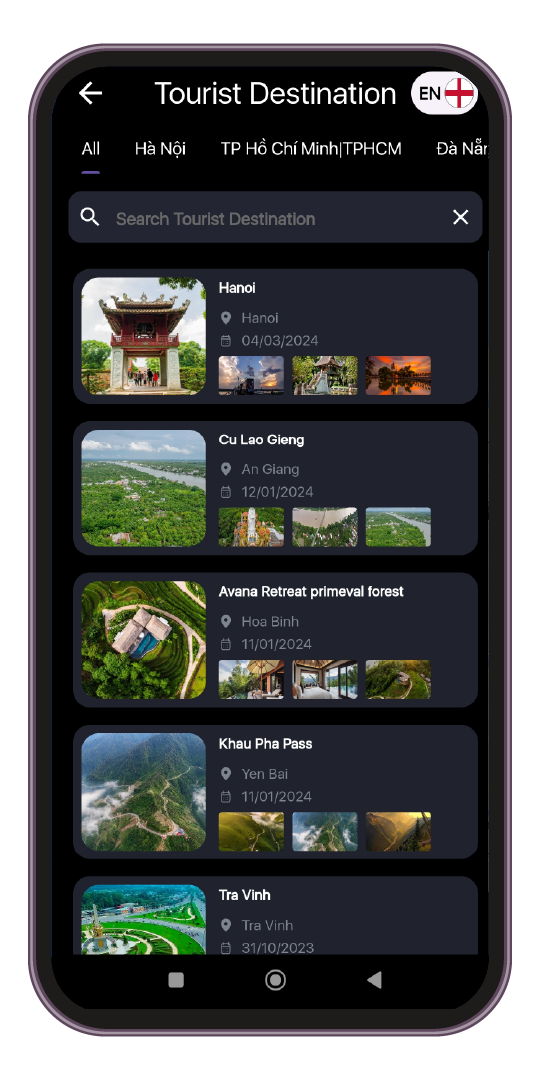Ponagar Tower is a temple located on top of a small hill about 50 meters above sea level, also known as Thap Ba Mountain at the mouth of the Cai River, about 2 km north of Nha Trang city center. The overall architecture of Ponagar consists of 3 floors, going from bottom to top. On the lower level, level with the ground, is the gate tower that no longer exists. From there, there are stone stairs leading to the middle floor. The middle floor is called Mandapa (i.e. guest house, retreat house) for pilgrims to rest and prepare offerings. Mandapa is 20m long, 15m wide, including 4 rows of octagonal columns (including 10 large columns and 12 small columns). On the body of the large columns there are mortise holes, cut deep into the body of the column, symmetrically level with the tops of the small columns. The top floor is where the towers are located. The towers are built in the Cham style, the bricks are very tight, no adhesive is visible. The main worship tower in the front row is quite large and about 23 meters high, which is the Ponagar tower. The tower has 4 floors, each floor has a door, stone statues of gods and animals. Inside is a statue of the goddess (2.6 m high) carved from black marble (previously made of agarwood, and further made of gold) sitting on a majestic lotus-shaped stone pedestal, with her back resting on a stone slab. large bodhi leaf shaped. This is a masterpiece of Champa sculpture, a harmonious combination of round and embossed statue techniques. At the top of the tower there is a statue of Shiva riding the bull god Nandin and statues of mascots. Ponagar Tower is a typical work of Cham ethnic architecture and sculpture. Construction techniques from the 8th to 13th centuries are still a mystery, although many researchers have participated and many scientific works have been carried out. People still do not understand how the Cham people managed to make the 20x20cm bricks overlap tightly without any adhesive. That is a unique feature that makes visitors love this tower temple more. Technically, all of these towers are built of bricks and artistically decorated with stone and ceramic materials. The content expressed is also associated with the gods worshiped here. Stone sculptures represent different themes according to the Brahmin religion, such as round statues (currently on display at the Khanh Hoa Provincial Museum) attached to the temples and towers forming an array of stone sculptures. Beautiful artistic architecture. On the annual Mother's Day (from 20th to 23rd of the third lunar month), Ponagar Tower welcomes tens of thousands of pilgrims as well as local people to attend the festival to commemorate the merits of Thien Y Ana. Thanh Mau (Cham people call it Po Inu Nagar), the mother of the country, has taught people how to do business and live. In history books as well as the subconscious of the Cham people, the role of goddess Po Inu Nagar is especially important and is the only woman symbol who is worshiped independently. People believe that Po Inu Nagar is a powerful and creative god... Motherland not only supported the Cham people from the first steps of the nation's founding but always guided the spiritual life of each family as well as the whole country. community. According to researchers, from the mid-17th century until now, the ceremony of worshiping the Motherland has been carefully organized by the Cham and Kinh people at Ponagar Tower. In 1653, Vietnamese people from the North followed Lord Nguyen to the South to open up the world, stopping at the mouth of the Cai River (Nha Trang), establishing villages and hamlets... And, they brought with them the custom of worshiping Worship the Mother Goddesses of the Kinh people in the Northern Delta here. Every year, on the 20th day of the third lunar month, Cham and Kinh people everywhere bring offerings and make a pilgrimage to Ponaga Tower in Nha Trang to sincerely express their gratitude to a woman who has He teaches good people how to do business and make a living through farming. The main rituals of the Ponagar Thap Ba festival include the Muc Duc ceremony (statue bathing), the family sacrificial ceremony (clothing changing ceremony) taking place at noon on the 20th day of the 3rd lunar month, followed by the sacrificial ceremony and offerings of food. Offerings and shadow dances invite the celestial goddess and other gods to attend the ceremony. According to ritual, the ceremony to worship the Holy Mother often begins with a prayer ceremony to pray for peace and prosperity for the country and people. The birth sacrifice ceremony begins at the hour of the Rat, the night of the 22nd lunar month, performed by elders, then the official worship ceremony takes place at 4 a.m. the next day... Famous dances of the Cham people include: Apsara, the harbor of love, neighborly love... along with the joyful sound of the Saranai flute and guitar drums, captivates the hearts of many tourists.
Khanh Hoa 1309 view From January to December
Ngày cập nhật : 26/03/2023


 vn
vn en
en ja
ja ko
ko zh
zh
















































































































































































